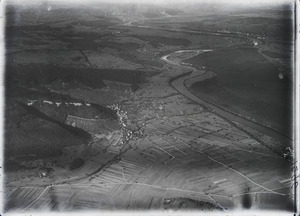Villigen facts for kids
Quick facts for kids
Villigen
|
||
|---|---|---|
 |
||
|
||
| Country | Switzerland | |
| Canton | Aargau | |
| District | Brugg | |
| Area | ||
| • Total | 11.21 km2 (4.33 sq mi) | |
| Elevation | 367 m (1,204 ft) | |
| Population
(Dec 2020 )
|
||
| • Total | 2,120 | |
| • Density | 189.1/km2 (489.8/sq mi) | |
| Postal code |
5234 Villigen 5233 Stilli
|
|
| Surrounded by | Böttstein, Brugg, Hottwil, Mandach, Remigen, Rüfenach, Untersiggenthal, Würenlingen | |
Villigen is a town, also known as a municipality, in Switzerland. It is located in the Brugg district within the canton of Aargau. A canton is like a state or region in Switzerland. In January 2006, another nearby town called Stilli joined Villigen.
A very important science center, the Paul Scherrer Institute, is mostly located in Villigen. This institute does a lot of research, even though part of it is across the Aare river in Würenlingen.
Contents
Villigen's Location and Landscape
Villigen covers an area of about 11.22 square kilometers (which is about 4.33 square miles). This area is made up of different types of land.
Land Use in Villigen
Almost half of Villigen's land, about 49%, is covered by forests. These forests are very dense. About 34.6% of the land is used for farming. This includes fields for crops, pastures for animals, and areas with fruit trees or vineyards.
About 13.5% of Villigen is built up with buildings and roads. This includes homes, businesses, and transportation routes. A small part, about 2.8%, is made up of rivers and streams. There are no lakes in Villigen.
Villigen's Coat of Arms
A coat of arms is a special design that represents a town or family. Villigen's coat of arms has a blue background. On it, you can see a golden bear's paw pointing upwards. Above the paw, there are three golden five-pointed stars. Below the paw, there are green hills.
People and Population in Villigen
Villigen has a population of about 2,200 people. As of June 2009, about 22.6% of the people living in Villigen were from other countries. Over ten years, from 1997 to 2007, the number of people living in Villigen grew by 3.6%.
Languages Spoken in Villigen
Most people in Villigen speak German. About 88.8% of the population speaks German. Italian is the second most common language, spoken by 2.4% of the people. Albanian is the third most common, spoken by 1.7%.
Age Groups in Villigen
Looking at the ages of people in Villigen in 2008:
- About 8% of the population are children aged 0 to 9 years old.
- About 11.1% are teenagers aged 10 to 19.
- Adults aged 20 to 59 make up about 61.8% of the population.
- Older adults, aged 60 and above, make up about 18.8% of the population.
Homes and Households
In 2000, there were 711 private homes and apartments in Villigen. The average number of people living in each home was about 2.5. By 2008, there were 821 homes and apartments in total. About 45.1% of these were single-family homes.
Education in Villigen
Many adults in Villigen have a good education. About 77.4% of people aged 25 to 64 have completed either high school or a higher level of education, like university. In the 2008/2009 school year, 101 students attended primary school in Villigen.
Historical Population Growth
The number of people living in Villigen has changed over the years:
| Historical population | ||
|---|---|---|
| Year | Pop. | ±% |
| 1975 | 905 | — |
| 1980 | 922 | +1.9% |
| 1990 | 1,248 | +35.4% |
| 2000 | 1,427 | +14.3% |
Interesting Places in Villigen
The village of Villigen is recognized as a special place in Switzerland. It is part of the Inventory of Swiss Heritage Sites, which means it has important historical or cultural value.
Villigen's Economy and Jobs
In 2007, Villigen had a low unemployment rate of 1.51%. This means most people who wanted to work had jobs.
Types of Jobs in Villigen
Jobs in Villigen can be divided into three main types:
- Primary Sector: This includes jobs related to farming, like growing crops or raising animals. In 2005, about 89 people worked in this sector.
- Secondary Sector: These jobs involve making things, like in factories or construction. About 33 people worked in this sector.
- Tertiary Sector: This is the largest sector and includes jobs that provide services, like working in offices, shops, or at the Paul Scherrer Institute. About 1,966 people worked in this sector.
Many people who live in Villigen travel to other towns for work. In 2000, about 75% of Villigen residents worked outside the municipality. However, many people also travel into Villigen for work. There were 1,268 jobs available in Villigen. About 16.4% of workers used public transportation to get to their jobs, while 50.6% used a private car.
Religion in Villigen
Based on a survey from 2000, people in Villigen follow different religions:
- About 34.5% of the population were Roman Catholic.
- About 46.3% belonged to the Swiss Reformed Church.
- A small number, about 0.22%, belonged to the Christian Catholic faith.
See also
 In Spanish: Villigen para niños
In Spanish: Villigen para niños






